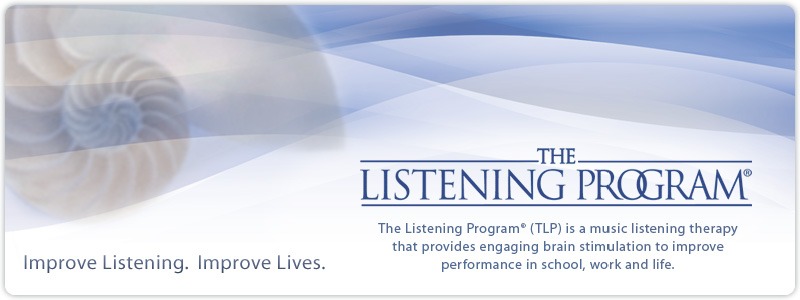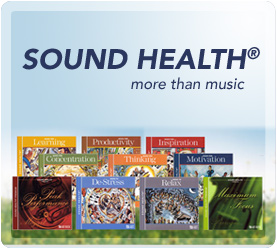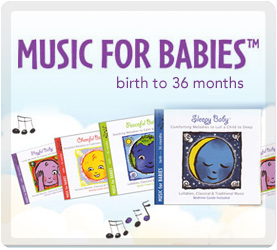
The Listening Program (TLP)
One of NACD’s approaches to addressing auditory tonal processing is The Listening Program (TLP). The program uses specially treated classical music to enhance listening skills and to “train” the brain to process sound in a more appropriate way.
Background
Before Bob Doman and NACD thought to put together a team to create The Listening Program (TLP), we at NACD tried a number of different approaches to sound therapy. Bob first learned of the work of Dr. Alfred Tomatis around 1976 while working with children in Spain. He met personally with Dr. Morales, Dr. Tomatis’ associate, and recommended the treatment to some of his clients. After he returned to the U.S. in 1978, some of his clients traveled to Paris to go through Dr. Tomatis’ treatment upon Bob’s recommendation. Eventually Dr. Tomatis’ work spread to the U.S. and continued to grow and evolve into other methods. NACD clients used Patricia Joudry’s recordings of the Tomatis Method on tape, called Sound Therapy for the Walkman. Next we used the Berard Method, Auditory Integration Training. When Ingo Steinbach’s method on CDs, Samonas Sound Therapy, became available, we were happy to have a method that better fit into our home program paradigm.
With an overwhelming number of our clients presenting with auditory processing problems of various forms, and with the positive benefits to varying degrees that we saw from using each of these methods, we believed that a music-based auditory stimulation program was a vital part of our treatment. However we also had growing concerns with the programs that existed, mainly that negative side effects were common. It became evident that what NACD needed for its clients was a program that did not exist. And so we put together a team of professionals to create a new program with the following goals in mind:
- cost-effective
- accessible
- easily implemented as a home program
- aesthetically pleasing
- easily tolerated by the listener, with a reduction in negative side effects seen with other programs
The primary team of professional given this task included: Bob Doman, his son Alex Doman, Dr. Ron Minson (a Tomatis practitioner), Joshua Leeds (musician, author, and lecturer on the effects of sound on the body), and Richard Lawrence (musician, composer, and sound engineer). NACD’s speech pathologist, Lori Riggs, also collaborated with the team on the technical design and directed the field test that was completed with the original program prior to its release.
And so…The Listening Program came into being. The original 8-CD program that was created by this team is now referred to as TLP Classic. Advanced Brain Technologies has gone on to produce the 10-CD program called TLP Level One. Under the supervision of Lori Riggs, NACD has used TLP Classic and TLP Level One with literally hundreds and hundreds of clients. We have vastly more experience with using auditory programs with children than any other single provider. As other auditory programs develop and come into vogue, we continue to assess all the options and continue choosing TLP as the program which best addresses the needs of our clients in a cost-effective way.
What is The Listening Program (TLP)?
The Listening Program (TLP) is a home-based sound stimulation auditory training method influenced by the sound theories of Dr. Alfred Tomatis and based on NACD’s three decades of clinical experience. Combining beautiful classical music and innovative sound processing techniques, the program promotes active listening and improves auditory perception.
The Listening Program (TLP) may be of special benefit to children and adults with sound sensitivities, hearing loss, learning and attention deficits, receptive and expressive language problems, perceptual difficulties, developmental delays, and other auditory processing problems.
TLP Classic consists of eight specially developed CDs with a Guidebook and Listening Journal. Each The Listening Program (TLP) CD contains four progressive segments that last 15 minutes each. The listening content is comprised of re-arranged, specially engineered classical music. TLP Level One consists of 10 specially developed CDs. It differs in treatment levels from TLP Classic. Your TLP provider will recommend a program for you, based on your specific needs. Although a typical listening schedule consists of two 15-minute sessions per day, five days per week, TLP schedules can be easily modified to meet the needs of an individual.
Easily implemented at home, TLP is administered under the supervision of a trained TLP provider. NACD offers The Listening Program both to our clients and also to individuals who are interested in an auditory program but are not participating in one of our comprehensive developmental programs. Long distance supervision is available.
What is The Listening Program For?
The main goal of The Listening Program (TLP) is two-fold: to improve (1) auditory tonal processing and (2) active listening (i.e. auditory attention). As these skills improve through the music and therapeutic techniques of TLP, we see improvements in a number of functional areas, including:
- listening
- sensory function
- learning
- speech and language
- reading
- attention
- memory
- auditory processing
- ability to process specific frequencies of sound
- vestibular function
- sound sensitivity
Although we have used The Listening Program (TLP) with many individuals who have a diagnosis of CAPD, the great majority of our TLP users do not have this diagnosis; they simply demonstrate weaknesses or difficulties in some of the functional areas discussed previously, such as sound sensitivity or speech and language development. It is not uncommon for parents to purchase TLP for their child in order to remediate specific developmental problems and then decide to go through the program themselves to enhance their own processing and listening skills. We encourage parents to go through the program along with their child and to use it with siblings as well. Afterall, in a highly visual society with an alarming decrease in auditory function, who couldn’t stand to boost their listening skills?
NACD’S Approach to Using The Listening Program (TLP)
TLP collaborator, researcher, and provider, NACD’s speech pathologist Lori Riggs supervises auditory programs for NACD clients around the world. With her vast experience using TLP with widely varied populations, she is able to make recommendations and modifications according to the needs of each individual and their family. Because the “treatment” of TLP is already built into the program, we do not require specific standardized testing to be completed prior to initiating the program. Candidacy for and use of the program is based on the functional information provided by the parents. NACD provides TLP with supervision only. Continued support and guidance is provided for the duration of an individual’s use of the program. While local families are welcome to consult with Lori in person, the majority of NACD’s TLP supervision is provided via long distance. Because TLP is implemented as a home program, consultation via phone and e-mail have proven to be an efficient, cost-effective means of supervision.
If you are already an NACD family or client and are interested in adding TLP to your program, please discuss this with your evaluator.
What Our Families Say About The Listening Program (TLP)
“She is listening and understanding for the first time.”
“…seeing profound changes.”
“Her speech has blossomed.”
“Her speech has improved tremendously.”
In reference to her child’s hypersensitivity to sound: “It went from out of control to completely controlled.”
“He’s more ‘there.’”
“His language has skyrocketed!”
One mother reported that her previously severely hyperauditory son was learning self-help skills for the first time because he no longer had to keep his hands on his ears all the time, finally freeing them for things like tying his own shoes.
More “tuned in.”
“I am writing in regards to The Listening Program. I recently purchased it and used it with my daughter. The program was the basic program, 2- 15 minutes sets per day. Having participated in both the Tomatis and the Berard methods in the past, I must say, this was not only more convenient, but easier overall. My daughter is 22 years old and is mentally disabled with autistic tendencies, she is also non-verbal and has behavior problems due to not having a good form of communication.
I decided to give your program a try, based on a parent’s recommendation with your previous program. After completion of our first 8 weeks I must say, I am extremely pleased with the results. My daughter has shown improvements in the following ways: More motivation, more verbal, calmer, more cooperative, more compliant, happier, more interactive, has more patience, she is willing to wait now, where as before the training she was not, and would react negatively. I also want to say, having Lori Riggs as my Provider, available whenever I needed, made this venture less frightening to me as a parent. Knowing that someone was there to help me if problems arouse was very reassuring. Lori was great. She answered all my questions and helped me with any concerns.
I have already recommended your home listening program to other parents and will continue to do so. We are starting on our second 8-week session. My daughter seems to enjoy listening now more than ever….This has certainly made our family’s life easier. Also, I need to mention, now that the noise of the vacuum cleaner does not bother my daughter anymore, she is actually starting to help with the vacuuming.”
Sincerely,
Lori Scholtes
FREQUENTLY ASKED QUESTIONS
Q: Without doing a hearing test, how do I know if my child is (or I am) a candidate for TLP?
A: TLP addresses listening skills and auditory processing, not “hearing,” per se. An individual’s development and function is more informative when it comes to looking at processing skills than what a hearing test (audiogram) is. You (or your child) may be a candidate for TLP if you have difficulties in any of the following areas:
- hypersensitive to sound
- hyposensitive to sound
- speech production
- language skills—receptive and/or expressive
- focusing when background noise is present
- attention
Q: What if my child won’t wear headphones:
A: For very young children or children who are sensitive to the feel of headphones on their heads, we do offer a speaker protocol using CDs that have been engineered specifically for loudspeakers. However we find TLP to be most effective when administered via headphones. Therefore in most situations we will provide specific suggestions for training headphone use, even for children who initially start TLP via speakers.
Q: Should I expect to see negative side effects with TLP?
A: Probably not. Prior to TLP, we frequently saw negative behaviors and poor tolerance with the use of other methods. However the specific and gentle engineering of TLP provides a pleasant listening experience that most listeners tolerate very well. For those few individuals who do experience any difficulty with tolerance, our very experiences provider can modify the program as needed to alleviate this.
Q: How long will it take to see results?
A: Because each individual responds differently and at different rates, it is not possible to provide an accurate, specific answer to this question. Some individuals experience an immediate response, while others may take weeks or months to become aware of change in function.
Q: Does that mean I have to continue using TLP in order to maintain benefit from it?
A: No. The goal of TLP is to make permanent change. We use TLP for relatively short periods per day over a longer period of time in order to accomplish this goal. While other methods may be shorter, the effects of these short, intensive programs tend to fade after a few months. The longer use of TLP tends to make changes that “stick,” as well as ensuring you get the maximum benefit from your program.



